Menu
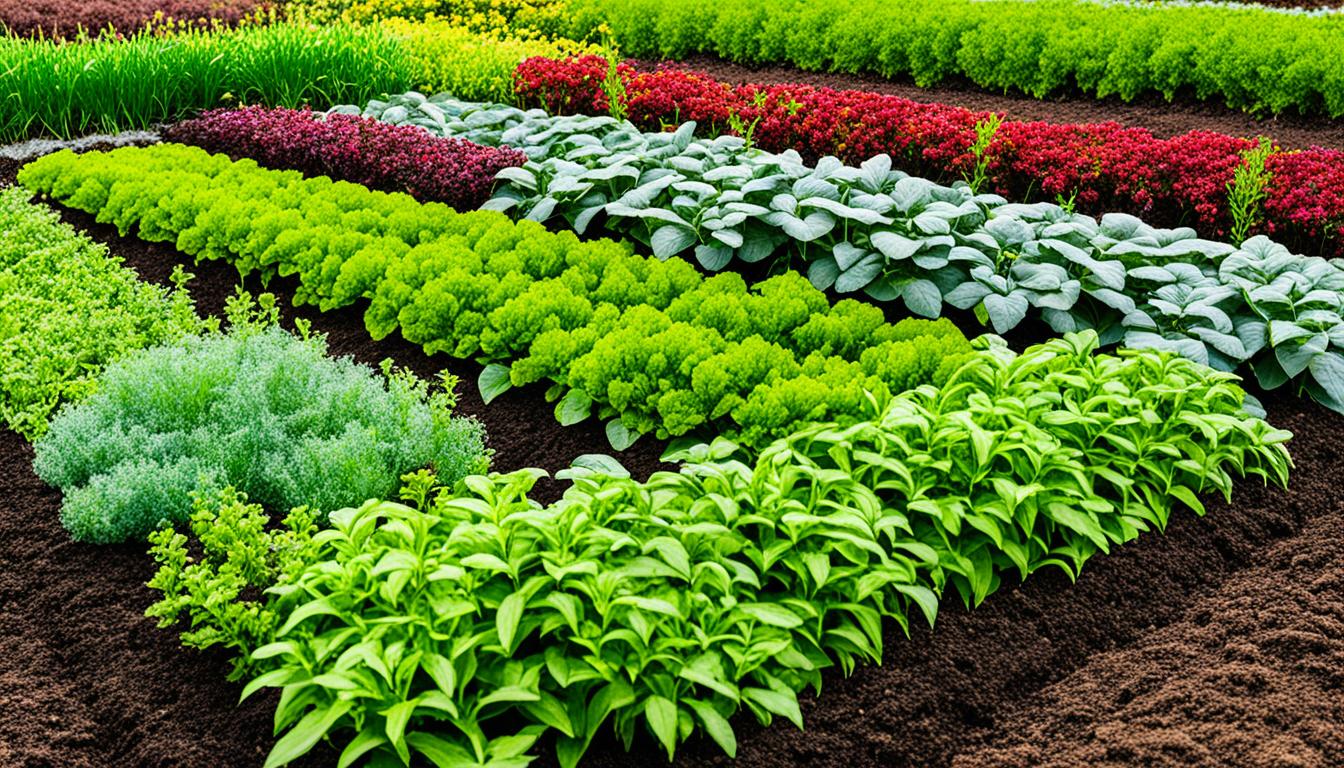
Did you know that in the 2021 fiscal year, American farmers planted cover crops on 2.3 million acres? This was all part of the Environmental Quality Incentives Program (EQIP). It really shows how big an impact soil health rules have on farming that cares for the Earth. The Natural Resources Conservation Service (NRCS) put $38 million into a new program in 11 states to help farmers grow better crops. This shows a strong effort to look after our land better.
This year, farmers stuck with their promise to care for the land better. They kept up with 2,600 Conservation Stewardship Program (CSP) contracts, looking after 3.4 million acres. The NRCS’s plan for the future is to have 30 million acres of corn and soybean fields also covered. These goals show how we’re moving towards farming that’s good for our planet and good for us.
Soil health policy is a detailed set of rules and actions. These help keep the soil good for farming and protect the environment. It’s all about using the land wisely to make sure our activities don’t harm the soil.
Soil health policy aims to keep our soil strong and alive. It makes sure the soil can stay busy and handle different jobs well. For example, trying some different ways of taking care of the soil can really make it healthier, especially in places that grow a lot of vegetables.
Soil is crucial for our world to work well. It provides food, helps keep our climate balanced, and supports plant and animal life. Plus, how we farm and how the weather acts can change the health of the soil.
Thanks to studies, like one in 2018 by Wood and others, we know certain things make soil better for growing food. Also, in 2018, a special program in the United States showed us how important it is to take care of the soil.
About 40% of the U.S. is used for farming. So, policies and projects about soil health help make sure our land lasts long and stays productive. They also help keep our ways of farming friendly to the environment.
“Local and federal policies sculpted to nurture soil health are essential for securing the longevity of arable land, thus supporting human life and preserving the broader environment.”—Sustainable Soil Management Assessment Framework (SMAF)
In short, soil health policy is vital for successful farming. By using smart ways to manage the land and making clear rules, we protect our soil for the future. This benefits both our farms and the natural areas around us.
Soil health policy in the USA has evolved significantly over time. This journey shows a deep connection to agricultural laws and major environmental steps. From the early 20th century to now, the focus has been on sustainable farming and protecting the soil.
The Dust Bowl years of the 1930s were crucial. Massive dust storms hit the country, ruining farms. Because of this, the Soil Conservation Service started in 1935 to help save the soil. This was the first big step towards caring for the land.
The landmark 2018 Farm Bill was a turning point. More funds went to help farmers use good soil practices. Techniques like crop rotation and cover cropping were encouraged. The bill also saw the birth of the Soil Health Division. This move underlined the nation’s serious interest in better soil.
Important steps have been taken in improving soil health across the country. By February 10, 2024, 26 states had laws in place to promote Healthy Soils. Pennsylvania was the first to do this. Together, these states cover more than half of U.S. farms and most of the people. So, these new laws are making a big impact.
Nearly every state with Soil Health plans has also set up a specific body for this work. States like California and Michigan are heavily involved. This shows that taking care of the soil is seen as key to a healthy environment and farming future.
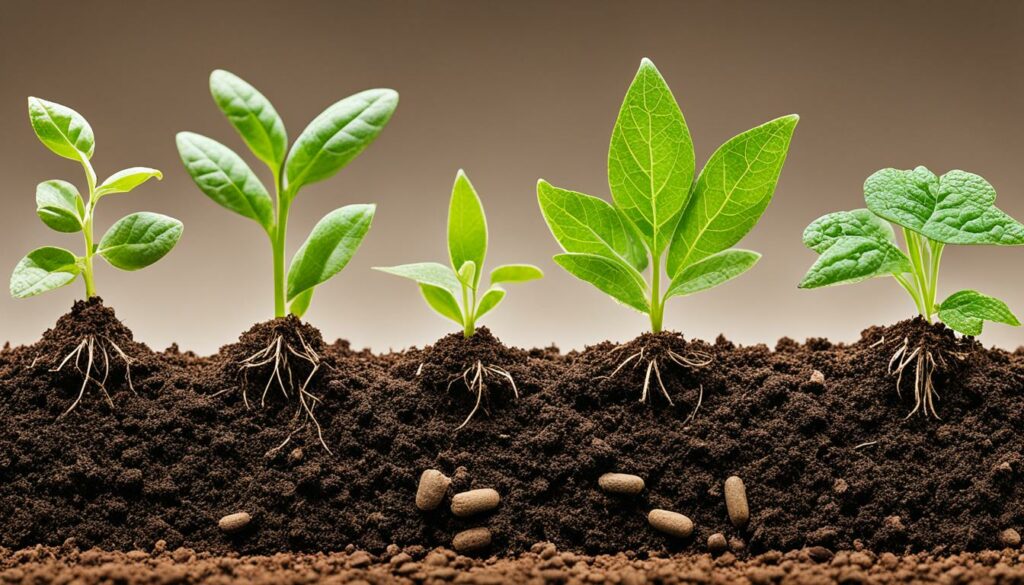
We’ve also seen a lot of support for these new policies. Articles, money plans, and tools for planning have been shared. Since 2016, the USA has seen a wave of over 20 soil health proposals each year. This big jump in attention shows how important these issues are becoming.
“Soil health policies in the USA are bringing many good practices together. They’re helping keep our land strong, supporting a lasting farming future.”
Looking ahead to 2023, it’s clear that our soil health work is both a reaction to past struggles and a plan for the future. This effort aims to safeguard our environment and keep farms going strong.
The National Healthy Soils Policy Network (NHSPN) has grown a lot since 2018. It was set up by the California Climate and Agriculture Network (CalCAN). This was to spread California’s good farming policies.
Now, it includes many farming groups. It has helped grow policy work across the U.S.
The NHSPN started with a few but now has 28 member organizations. They’ve introduced 62 pieces of legislation for healthy soils.
Together, they’ve got 31 bills passed and started 7 soil programs in states outside of California. They’ve helped get over $48 million for soil projects in 26 states.
The NHSPN has many members, each doing important work. For example, the California Climate and Agriculture Network leads California’s efforts. The Hawaii Farmers Union United helps farmers in Hawaii. The Maine Farmland Trust protects land and supports farmers in Maine. The New Mexico Healthy Soils Working Group works to improve soil health practices.
Many different groups from all over, like the Northeast Organic Farming Association of Vermont and Oregon Tilth, work together for better soil health.
The NHSPN has made a big difference with many accomplishments. They’ve had over 60 virtual events and trained farmers. Over 380 farmers have joined their advocacy in 2020.
Groups like the Kansas Rural Center and the Ohio Ecological Food and Farm Association are working on soil initiatives. They’re helping the network grow and do better work.
The NHSPN also helped with 77 mini-grants, giving $405,434 to 27 groups. This shows their strong support for a healthy soils network in the country. They’re pushing for sustainable farming and better soil policies.
In recent years, many steps have been taken to improve soil health across the UK. These efforts occur at all levels – federal, state, and local. They aim to manage land wisely and upgrade farming methods.

The UK government is boosting its support for healthier soils. The Inflation Reduction Act of 2022 provided a lot of money for conservation. The Environmental Quality Incentive Program (EQIP) got an extra $8.45 billion. The Conservation Stewardship Program (CSP) got a $3.5 billion lift. Also, the Agricultural Conservation Easement Program was funded with $1.4 billion, and the Regional Conservation Partnership Program received $4.95 billion.
The 2022 act also set aside $300 million just for soil health improvement actions. This boost shows the government’s strong focus on better land and farming practices.
States all over the UK are adding their part to the soil health drive. They aim to improve the soil in ways that suit their area best. For example, the 2018 Farm Bill started the Soil Health and Income Protection Program. It uses new data methods to boost soil quality. States like California have launched their own Healthy Soils Initiative. This program connects soil health efforts with the particular climate and culture of the region.
Communities and smaller projects play a big part in making soil health policies a reality. They introduce green methods to fight soil problems and manage rains. The Swinomish tribe in Washington has joined the CDC’s BRACE framework to highlight the health of their land.
Local groups and farmers also come together to help. A project called the Partnerships for Climate-Smart Commodities is a great example. It worked on 141 projects with a budget of $3.1 billion in 2022. These local projects greatly help in making farms strong and suited to their specific community.
Sustainable agriculture is key to maintaining our soils. With the world’s population expected to reach 8.9 billion by 2050, the need for food will rise. So, it’s crucial to use farming methods that protect our earth.
Cover cropping, crop rotation, and conservation tillage are at the core of sustainable farming. They help keep soil healthy by reducing erosion and supporting diverse wildlife. Keeping our soil rich ensures it can support crops for years to come.
Research shows that the health of our soil depends on tiny creatures like bacteria and fungi. These soil biota indicators affect things like crop growth, fruit quality, and water retention. For instance, helpful microorganisms such as arbuscular mycorrhizal fungi (AMF) are key to plant growth.
An interesting study looked at growing wheat in the same field for several years. It found that this reduced the soil’s health and the quality of the water below. On the other hand, using methods like organic farming improved the soil life. It made crops like watermelon and globe artichoke grow better in certain soils. A study on watermelons showed that conservation tillage increased the number and activity of soil fungi.
Here’s a breakdown of the benefits various farming methods offer:
| Technique | Soil Biota Enhancement | Impact on Yields | Additional Benefits |
|---|---|---|---|
| Cover Cropping | Increases microbial diversity | Stable yields | Prevents soil erosion |
| Crop Rotation | Reduces pathogen build-up | Higher crop quality | Improves soil nutrition |
| Conservation Tillage | Enhances fungi activity | Comparable to conventional | Boosts carbon sequestration |
Combining old and new farming practices helps protect our soils. It also helps fight climate change and assures we have enough food. As the farming sector grows, it’s important to keep using smart and earth-friendly methods.
Organic farming is increasingly seen as a key player in improving soil health. It also helps fight climate change. These systems keep the farm rich in biodiversity and support ecological cycles. This makes soil healthier by boosting soil life and organic carbon levels.
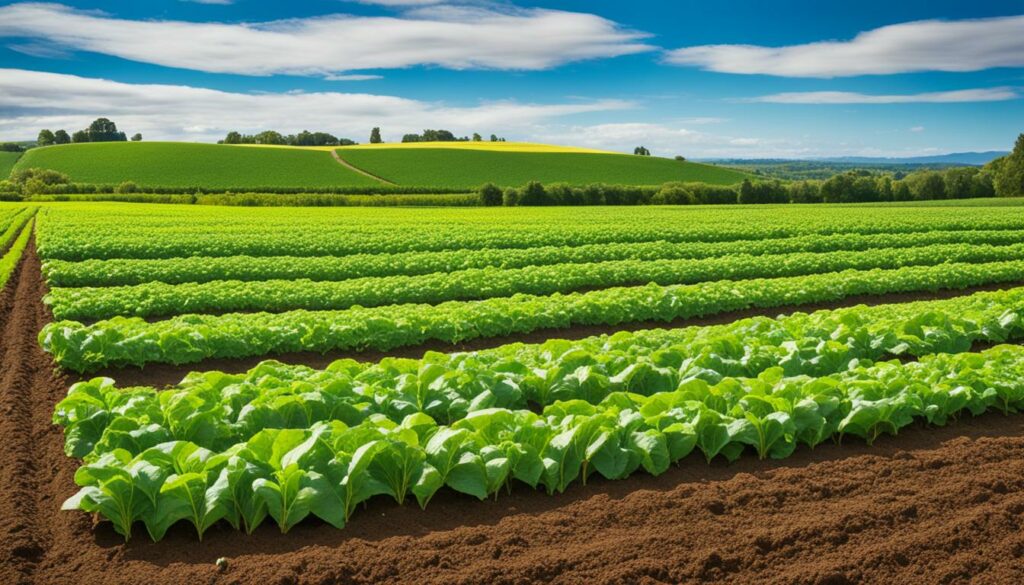
Organic farming benefits go beyond avoiding synthetic chemicals. They improve soil structure and boost microbial and fungal life. This connects to less intense farming and more plant diversity. Research shows such farms have better soil qualities.
Organic soils contain more organic matter on average than conventional soils. This means they have richer microbial life. For instance, a national study showed organic soils had over 8% organic matter. Conventional soils had just over 7%. This big difference highlights how organic farming supports long-term soil health.
Case studies also prove organic farming’s soil health benefits. In Beltsville, Maryland, no-till and strip-tilled organic plots emitted less nitrous oxide. This gas is a potent greenhouse gas. Meanwhile, Canada’s organic farms show that various approaches in management impact soil quality. Here, farmer choices influence how well soils improve.
In the US, certified organic food and drink sales hit US $63 billion in 2011. This growth shows people want organic goods. Consumers are drawn by the health benefits and the farming principles. This shows consumer views are in line with the strengths of organic farming.
These studies underscore the need to learn more about managing farms for better soil. This knowledge can help to keep improving soil health and the services agriculture systems provide.
Preventing soil degradation is key to keeping our food and ecosystem healthy. Farmers can secure their future by using smart soil care and land management. Techniques include conservation agriculture, planting trees, and managing animal grazing. These methods boost soil, making farms more sustainable.
Conservation agriculture means disturbing soil less, covering it, and changing which crops are planted. This helps soil stay put and hold more water.
Agroforestry mixes in trees and bushes on farms to stop soil from washing away. It also adds more plant and animal variety and captures carbon. Trees break the wind and slow down water, protecting the soil.
By moving animals to different grazing spots, controlled grazing avoids areas being eaten bare. This step lets plants grow back, keeping the soil healthy.
These solutions have worked well in different places. In the Midwest, applying conservation agriculture has cut soil erosion and boosted harvests.
In California, planting trees in farms has made the soil richer and better at holding water. This helps the environment and farming. In the Southern Plains, planned grazing has made the soil and nature stronger.
| Technique | Benefit | Success Example |
|---|---|---|
| Conservation Agriculture | Reduces soil erosion, enhances water retention | Midwest USA: Decreased erosion, higher yields |
| Agroforestry | Prevents soil erosion, improves fertility | California: Enhanced fertility and water retention |
| Controlled Grazing | Prevents overgrazing, maintains soil integrity | Southern Plains: Improved soil health, increased biodiversity |
Improving soil fertility mixes various methods and relies on new farming techniques. This helps farmers better their soil health and output. I aim to talk about ways, both old and new, to manage soil fertility.
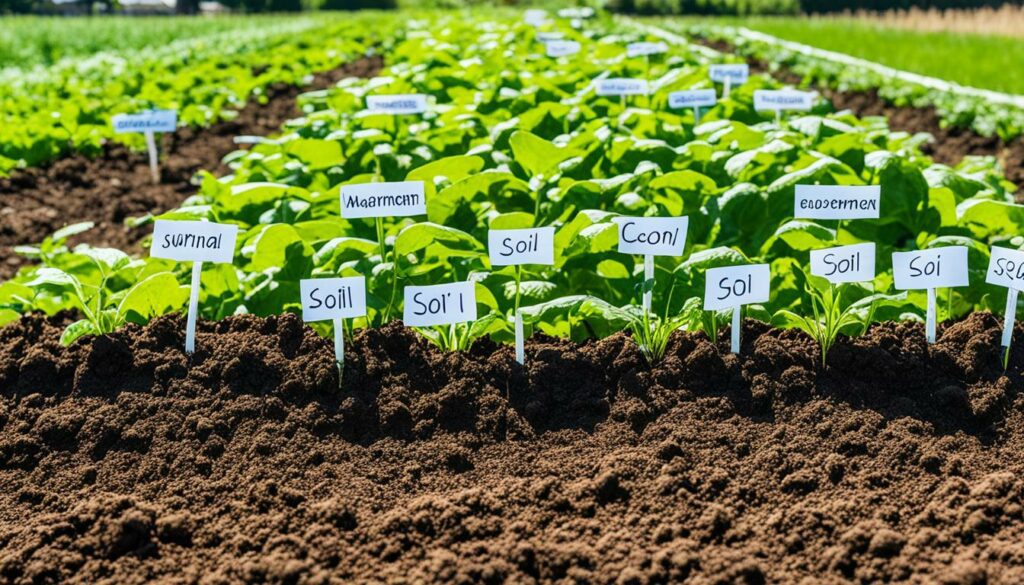
To keep soil fertility right, many ways are used. These follow key rules for soil health by the USDA-Natural Resources Conservation Service. They include less soil moving and wider plant variety. The main techniques are:
| Method | Benefits |
|---|---|
| Integrated Nutrient Management | Enhances nutrient availability, promotes soil health |
| Organic Amendments | Increases organic matter, improves soil structure |
| Biofertilizers | Boosts nutrient uptake, supports beneficial microorganisms |
With farming changing, new ways to handle fertility are critical. This includes:
Both old and new soil fertility techniques offer a lot. Cover crops, for instance, are key for soil health and cutting erosion. Plus, rotating crops like adding winter wheat after soybeans helps a lot.
Statistics:
It’s obvious that new soil fertility methods and good fertility management are a must for today’s farming. By using these, we not only better the soil and its health but also ensure long-term productivity and look after our environment.
Government support is crucial for farmers to practice sustainable soil health across the U.S. The USDA provides regulations and farm incentives. These help farmers use better soil management tactics. They aim to improve soil, help the environment, and boost farming.
The USDA has many rules to promote healthy soil and good farming habits. The Farm Bill, for instance, helps with special programs.
The USDA also offers many incentives. These encourage better soil health practices with financial help.
By February 10, 2024, 26 states had rules for healthy soil. They cover over half the U.S. farms. These laws show how much the U.S. cares about soil health. Nine more states are working on similar rules to help soil everywhere.
The USDA’s strong support and farm aid show its dedication to better soil health. New rules and incentives promise a better future for farming. They aim for a strong and fruitful land for years to come.
Environmental conservation and soil health are deeply linked. To save our planet, we must focus on keeping our soil healthy. The idea of ecological farming shows how working with nature can be good for everyone.
By February 10, 2024, 26 US states had laws supporting soil health. Pennsylvania, for example, set up a Soil Health Program. These states make up over half of America’s farms and nearly two-thirds of its people.
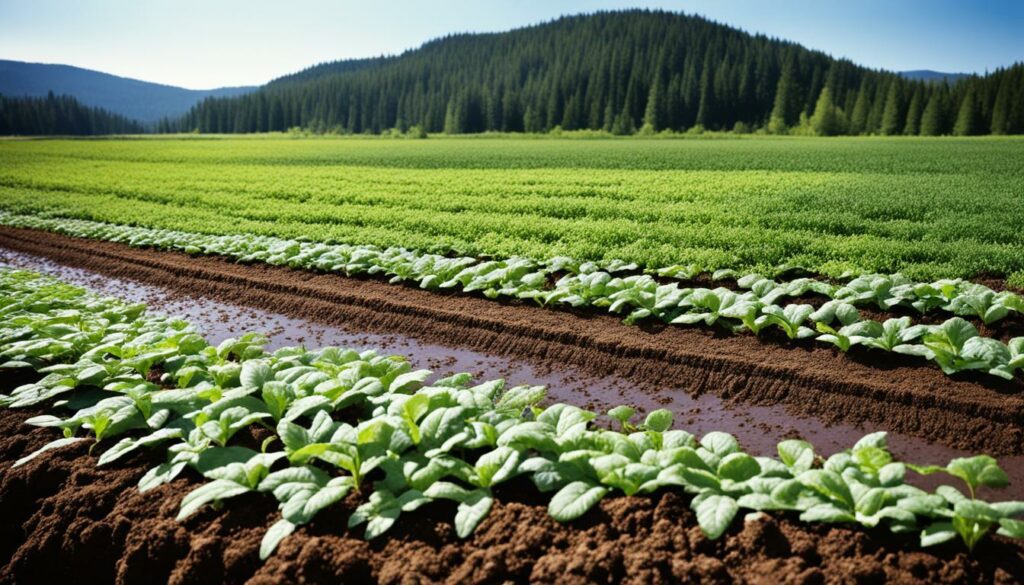
This shows a big effort in America to protect the environment by improving soil health. Places like California, Colorado, and Illinois have special groups to help farmers. They give rewards to those who take care of their soil.
The effort isn’t just in the US. The European Union (EU) is also fighting soil problems. Over half of Europe’s soils need help, which costs the EU a lot of money each year. A new law in the EU wants all soils to be healthy by 2050. This law will fight against soil problems like erosion and pollution, encouraging good soil care.
| State | Legislation Details | Population Coverage | Total Farm Acreage |
|---|---|---|---|
| California | Established agencies and incentives | 50 million | 25.5 million acres |
| Pennsylvania | Implemented Soil Health Program | 13 million | 7.3 million acres |
| Massachusetts | PFAS Remediation Trust Fund | 7 million | 467,000 acres |
In the US, the focus on soil health is growing. Support for ecological farming and smarter land use is key to preserving our world. These actions help keep nature diverse, boost what nature gives us, and keep farming sustainable.
Soil health is crucial for various ecosystems to keep going. It’s key for ecosystem sustainability. Brevik’s work shows that soil is vital for services like recycling nutrients, filtering water, and providing habitats.
Soil is the base of many services. Keith, Schmidt, and McMahon say looking after the soil connects these services to the ecosystem’s health. Good soil helps plants and animals grow, keeps water clean, and air fresh. This makes the environment stronger.
In many places, soil health keeps ecosystems running. Norris and Congreves found that better farming and land care improves soil and ecosystems. This boosts nutrient cycles and water regulation, helping nature thrive.
The European Union aims to save biodiversity and improve nutrient cycles by 2050. These goals need good soil care. It can lower flood risks and keep water clean. This shows how important soil is for ecosystems.
Soil is vital for all kinds of ecosystems to work well. Taking care of the soil means we keep getting the services we need from nature. It’s central for a healthy planet and future.
Climate-resilient agriculture tackles the impacts of climate change on farming. It blends principles for a sustainable environment and economy. This helps agricultural systems cope with changing climates, keeping productivity and food security high.

Farmers today need adaptive techniques to face climate change. Methods like no-till farming and cover cropping are key. They trap carbon in the soil and cut down on nitrous oxide. This means better soil health and less greenhouse gases. The American Farmland Trust (AFT) praises these methods in its report.
The AFT also works on climate-smart projects with Truterra of Land O’Lakes. These joint efforts are vital for finding farming solutions that really work.
To help farmers use climate-friendly practices, we need resilience policies. The 2023 Farm Bill is crucial in this area. The AFT is pushing to make this bill support climate-resilient farming. It aims to cut emissions while making farms more profitable.
The AFT receiving a $30 million grant from the USDA for climate-smart farming is huge. This grant will make farming more sustainable, especially in beef production.
In New England, local solutions are key. Groups like the Boston Food Forest Coalition promote inclusive food systems. They stress the importance of community and fairness in farming and food distribution.
“A Just Transition in agriculture emphasises governance and democracy. It knows that moving to sustainability is about changing power and access.” – American Farmland Trust
To conclude, climate-resilient and adaptive agriculture are vital for our future. Strong policies and community efforts support these techniques. They ensure a future where farming is both resilient and fair.
Climate change really affects our soil. It impacts farming and nature all over the world. In 2020, studies showed we lose about 24 billion tonnes of good soil yearly. This is causing big problems because nearly 40% of all lands are not healthy. The UN warns that this is a worry for us all.
The changing climate makes the soil less healthy. It causes more soil to wash away and leads to dry spells. The European Commission tells us Europe loses nine million tonnes of soil every year due to this. The UK alone spends £1.2 billion each year because of this damage. About half of the world’s farming lands have already suffered. If things don’t change, we will have lower food supplies by 2045. This is bad news for places that rely on farming.
To combat these issues, we can do many things. ‘Carbon farming’ is one key solution. It aims to trap more carbon in the soil. Did you know healthy soil can hold eight times more water than all the rivers in the world? This helps us fight dry spells and floods. Better farming methods are vital. They help use the land smarter to fight climate issues. Some actions include improving how the soil can grow food and holds carbon.
Research has shown that smart actions can help lessen climate harm. A look at 20 examples from Europe showed that these actions can make a real difference. They should reduce the risk of soil washing away and increase carbon in the soil. But, in some cases, the soil may get too hard due to these actions.
Farmers are starting to change because they see the need. They are using new ideas and reacting to the changing market. In Europe, a big study with 20 examples over 13 countries showed how new plans can help. By talking with the farmers, they found the best ways for them to adapt. This helped to better understand what really works.
Farmer-led efforts have made a huge difference in sustainable farming. They focus on community projects and new farming techniques. For example, Rick Clark is improving soil health by using organic and regenerative methods.

In the United States, groups are leading the way in farming innovation. They include the Buffalo County Conservation Farmers and the Bad Axe Farmer-Led Watershed Council. These groups improve soil and water quality through teamwork, education, and farmer support. Their work highlights the power of coming together for a green future.
There are also farmers making big changes on their own farms. They use creative methods for better, more natural farming. Rick Clark’s switch to fully organic farming is a great example. He uses methods like crop rotation and cover crops. This cuts the need for chemicals, which is good for the environment.
His farm saw lower crop yields at first. But, he saved a lot of money in the long run. Innovative ways to stop weeds, like growing certain crops together, also show his smart farming.
Clark advises to start with small changes. He tells other farmers to get advice from local experts, like those at Purdue Extension. His work, including hosting events and sharing tips, helps others improve their farms too. This way, all farming can become more sustainable over time.
Together, community and farmer-led projects are making our farms better and stronger.
Soil health policy is moving towards a bright future. It’s all because of new knowledge and better technology. These changes will make farming more sustainable and adaptable. The soil policy of the future will be stronger and involve farmers more. This is thanks to new technologies and big plans.
In agriculture, people are focusing more on soil health. Looking at the facts, we see a growing interest in the value of soil and its role in keeping the land healthy. A lot more effort is being put into checking soil health and trying new ways to improve it. The importance of soil fertility has been a big influence on this shift.
Some problems have been identified, like it’s hard to measure soil organisms and we need to understand soil biodiversity better. To solve this, new ideas like not tilling the soil are being used. This helps make crops better and keeps more carbon in the soil, balancing productivity with saving the land.
There will be a lot more happening in soil health soon, with many states and new laws getting involved. Almost all states with these programs have set up special agencies to help with advice and benefits. California, Oregon, and Texas are just a few doing a lot for soil health.
The Soil Health for Our Future workshop showed how important it is to work together on soil health. It brought over 120 people from Canada and the EU together. They made 13 important suggestions to help the soil and its living things. Events like these show the power of working as a team on soil and farming issues.
| Indicator | Statistic |
|---|---|
| Soil Ecosystem Services and Natural Capital | 100% critical appraisal |
| Soil Health Assessment Achievements | 195:104365 |
| Alternative Management Practices | 6:50 enhancing soil indices |
| No-Till Management Impacts | 149:37-49 on crop productivity |
| States with Soil Health Legislation | 26 states as of February 2024 |
| Healthy Soils Programme Coverage | 27 states including 57.1% of US farm acreage |
Looking ahead, by working together and with new plans, we can make farming more sustainable and aware of the climate. By using new methods and caring for soil, we can make our land better for the future.
It’s clear that we need to find a balance between farming today and protecting our future. A good agriculture policy summary shows this. It says saving the soil is key for healthy food, saving animals, and fighting climate change.
Experts like Ladyman and Brevik show why we must keep the soil healthy. They say it helps the earth stay in balance and boosts farming. Using new farming methods, backed by strong rules, is vital for protecting our soil.
We must keep pushing for farm-friendly rules. Blum and Bünemann’s work proves some ways to make soil better. We need to make sure our farms are tough and healthy for the future. This shows the need to keep up our work on soil policies.
Soil health policy is a set of rules and actions to keep soil good. It helps grow food, keeps nature in balance, and fights climate change.
Soil health is crucial for food, nature, and dealing with climate change. Healthy soil means we can grow food for a long time and keep the planet healthy.
The Dust Bowl led to early soil-saving efforts. Over time, laws were made to help farming and the environment get along better.
This network, set up in 2018 by CalCAN, joins groups to make soil laws better across the US.
The government offers support like EQIP and CSP to promote earth-friendly farming.
States help farmers in different ways to keep the soil good. They offer advice and plans to protect the land and grow food smartly.
Using cover crops, changing what you plant each year, and not turning the soil too much are key. They keep the soil healthy and full of life.
It uses nature to help the soil, avoiding bad chemicals. This makes the earth strong, helps capture carbon, and fights climate change.
Farming in smart ways like not ploughing so much, growing trees near crops, and moving animals carefully stop the soil from getting bad.
They can add things to the soil that make it rich, like special compost and natural fertilisers. New tech and careful farming also make a big difference.
The government helps with money and advice to farm in good ways. They back things like covering the soil and caring for animals well.
Good soil means more life in nature. By protecting the soil, we help plants and animals to thrive.
The earth is like the home for many living things. By keeping the soil healthy, we make sure nature can keep helping us.
This kind of farming can deal with the ups and downs of the weather. It aims to keep farms strong and the nature around them healthy.
The changing climate can make it hard for the soil to stay good. Using new ways to farm and keeping water in the land can help.
Farmers are doing many things to keep their soil healthy. They plant different crops together, not only take from the land, and use good fertilisers. These smart ways help the soil and nature.
More and better soil rules are coming, focusing on helping farmers and the land. As we learn more, we’ll find new ways for farming to be good for both people and the planet.